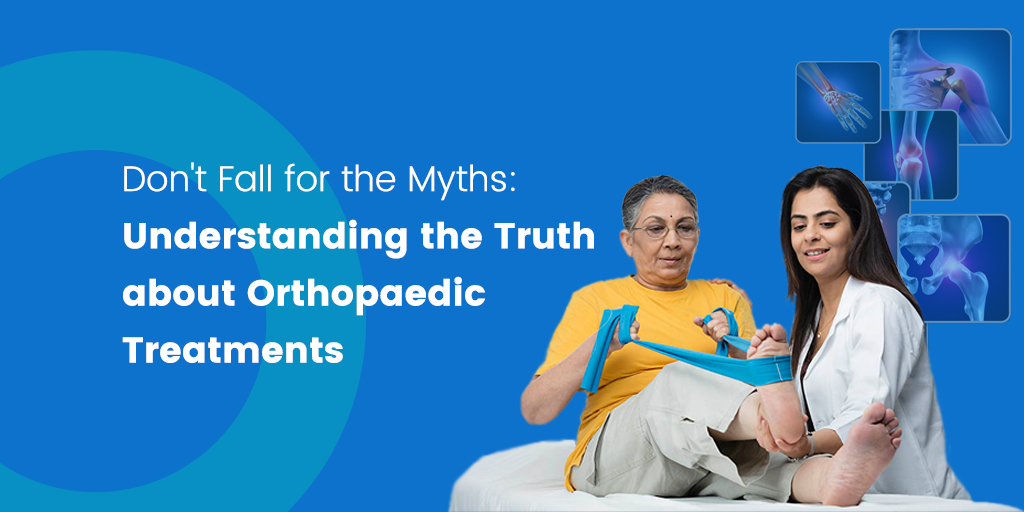When it comes to advanced orthopaedics and musculoskeletal challenges, some people prefer to conduct their studies. People reach out to friends, family, and, perhaps most importantly, the internet. While they haven’t got a clear understanding of orthopaedic treatments, it can lead to confusion, unnecessary fear, and delayed treatment.
There are countless myths and misconceptions about orthopaedic treatments that can confuse your awareness and prevent you from making informed decisions. It’s critical to distinguish fact from myth while seeking treatment for joint pain, fractures, or other muscle-related problems. In this detailed blog, we will reveal common myths about orthopaedic treatments giving you vital insights and empowering you to make informed decisions about your orthopaedic health.
Myth 1- Orthopaedic treatment is only for athletes and the elderly
There are several reasons why many individuals feel that orthopaedic treatments are primarily for the elderly and athletes. To start with, these are the two kinds of people who are most prone to suffer from musculoskeletal issues. Second, many orthopaedic treatments are tailored specifically to these groups. For example, joint replacement surgery is often reserved for the elderly, and sports medicine treatment options are intended to assist athletes in recovering from injuries.
Myth 2- Orthopaedic treatment is usually uneasy and invasive.
While some orthopaedic procedures may be uncomfortable, advances in pain control techniques have greatly improved patient experiences. Orthopaedic surgeons prioritize patient comfort and use a variety of techniques, such as local anesthetic, regional nerve blocks, and medication, to reduce discomfort during treatments and facilitate a faster recovery.
Myth 3- Orthopaedic treatments are only for acute injuries
Many individuals believe that orthopaedic treatments are primarily for acute injuries, which are frequently the most visible and painful musculoskeletal disorders. When a person twists their ankle or fractures an arm, it is obvious that they want medical attention. Chronic illnesses, on the other hand, such as arthritis or back pain, might develop gradually and may not be obvious.
Myth 4- Orthopaedic treatments are long-term.
Physical therapy and joint injections are two examples of non-permanent orthopaedic therapies. However, for a limited time, they can be quite successful in minimizing pain while improving functioning. If your illness is chronic, you may require multiple treatments throughout your lifespan.
Myth 5- Surgery is the first solution for any orthopaedic treatment
Surgery is not generally the first treatment for orthopaedic diseases. Many orthopaedic problems can be adequately controlled with conservative treatments such as physical therapy, medication, and lifestyle changes. Non-surgical procedures are frequently advised as first-line treatments, with surgery considered when conservative measures fail to offer adequate relief.
Why is it important to consult an orthopaedic doctor in the earliest possible?
- If you are experiencing pain or other concerns with your musculoskeletal system, you should see an orthopaedic doctor as soon as possible.
- Early intervention can help to avoid more harm and complications, allowing for more successful treatment.
- Furthermore, consultations allow patients to control pain and discomfort more quickly, thereby increasing their quality of life.
What are the different types of orthopaedic treatments?
- Physical therapy
- Joint Injections
- Arthroscopy
- Fracture Fixation
- Arthroplasty
The panel of Orthopaedic doctors at Durdans
- Dr. Ashan Abeyewardene
- Dr. David Alexander Young
- Dr. Hiran Amarasekara
- Dr. Parakrama Dharmaratne
- Dr. A. Ellawala
- Dr. R. Gnanasekeram
- Dr. J Jeyakumar
- Dr. S.D. Karunaratne
- Dr. Chandana R. Karunathilake
- Dr. R. Arul Kumaran
- Dr. Harsha Mendis
- Dr. Dilshan Munidasa
- Dr. W.G.R. Primal Peiris
- Dr. Ananda Perera
- Dr. Bandujeewa Piyasena
- Dr. J. Jeyakumar
- Dr. O.N. L. P. Dharmaratne
- Dr. G. L. Punchihewa
- Dr. Rukshan Sooriyarachchi
- Dr. V. Swarnakumaar
- Dr. Ajith Priyantha Ukwaththaarachchi
- Dr. M.B.P.Chinthaka Wijedasa
- Dr. Rajasekaram Gnanasekeram
- Dr. Sunil Wijesinghe
- Dr. Ananda Perera
Orthopaedic treatments available at Durdans
- Computerized Tomography (CT) Scans
- Electromyogram (EMG)
- Magnetic Resonance Imaging (MRI)
- Open biopsy (for diagnosing bone cancer)
- Ultrasound scans
- Dexa scan to diagnose osteoporosis
For more details on other orthopedic surgeries and procedures, you can visit https://www.durdans.com/orthopaedics/
Conclusion
Don’t let these medical myths jeopardize your understanding of orthopaedic treatment. We hope that by highlighting these common myths, you will be able to make better choices about your orthopaedic health. Always remember that orthopaedic treatments are not confined to specific age groups or surgical operations. They include a variety of alternatives aimed at relieving symptoms, promoting healing, and improving your overall healthAt Durdans, one of the leading private hospitals in Sri Lanka, we provide orthopaedic diagnosis services. You can seek medical attention for your orthopaedic problems or schedule a consultation with an orthopaedic doctor. You can dial +94 (0)11 2140 000 for Orthopaedics Consultations and appointments. If calling isn’t convenient for you, don’t worry! You can book an appointment through our chatbot; text ‘Hi’ to https://wa.me/94112140000?text=Hi.













